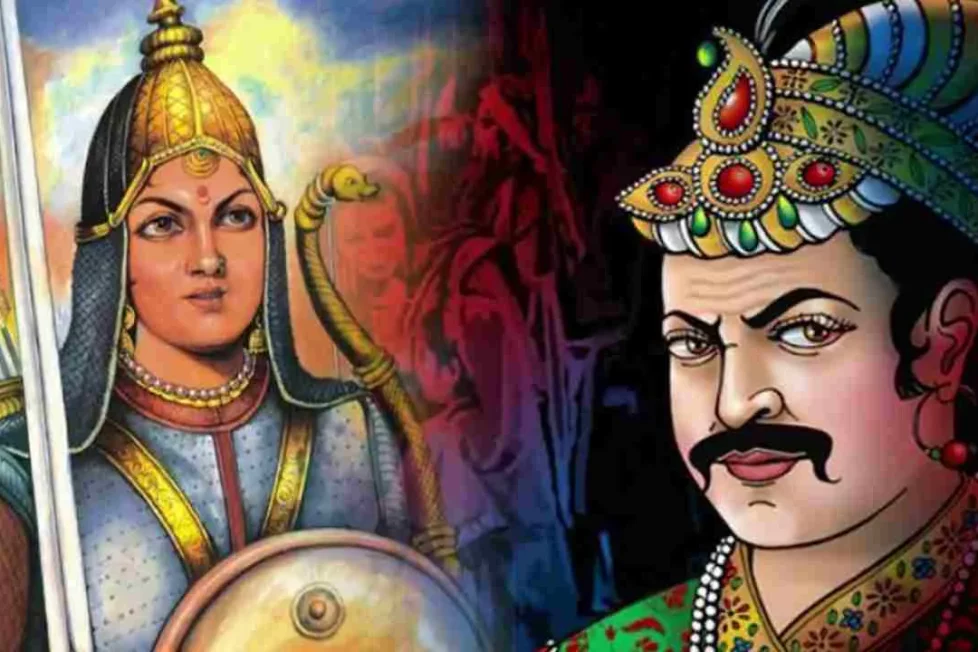The Gond Queen who challenged Akbar


The toughest problems of your life are presented to you by time, and only someone with courage and perseverance can meet them head-on. One such person was Rani Durgavati, who, in the face of harsh Mughal forces led by Akbar, stood up for herself and left her mark on the annals of history.
On October 5, 1524, Durgavati was born in Kalinjar, one of India’s most impenetrable forts. It is located in Uttar Pradesh’s Banda district. Her father was Raja Salbahan, the Chandel king of Mahoba. According to legend, she was given the name Durgavati since she was born on the fortunate day of Durga -ashtmi. She married Dalpat Singh, a Gond prince, at the age of 18. Sangram Shah, the ruler of Garh-Katanga, was the father of Dalpat Singh. The contemporary Madhya Pradesh districts of Mandala and Jabalpur were home to the Gond kingdom. This merger brought the Gond and Chandel dynasties closer together.
Rani Durgavati gave birth to a boy in the year 1545, and he was given the name Vir Narayan. She did, however, lose her spouse Dalpat Shah after five years. Since her child was so young, the intrepid queen opted to rule the kingdom by herself. This was a trying period for her. She efficiently ran the kingdom along with the dependable ministers Adhar Kayastha and Man Thakur.
She decided to relocate her capital to Chauragarh, which was thought to be safer than Singauragarh and was located in the Satpura hill ranges.
She was able to run the state with efficiency and make swift judgments, which led to greater wealth. 12 thousand of her kingdom’s 23 000 villages were under her government’s direct control.
Along with a large army of numerous foot soldiers, she also kept a war elephant army of 1,000 and 20,000 cavalrymen. She built the enormous Ranital reservoir in Jabalpur as part of her work on public utilities. Her minister Adhar Kayastha also constructed Cherital and Adhartal in the city. She put in a lot of effort to solidify her kingdom’s borders.
The legendary fighting prowess of Rani Durgavati is still told and sung about in the Madhya Pradesh region’s Mahakoshal folklore.
The Malwa monarch Baz Bahadur attempted to invade Durgavati’s kingdom between the years 1555 and 1560, but Durgavati repelled him, according to the Persian source tarikh-i-Farishta. Along with a number of foot soldiers, she also kept a sizable army of 20,000 cavalrymen and 1,000 war elephants. However, as time passed, a greater threat came closer to her homeland. After defeating Baz Bahadur of Malwa in 1562, Mughal Emperor Akbar took Malwa into the Mughal Empire.
Asaf Khan, the Mughal governor of Kara-Manikpur, developed a friendly connection with the Gond Kingdom and facilitated trade between the two nations. This aided Mughal expansion in gaining knowledge of Rani Durgavati’s soldiers and finances. Mughal forces began robbing neighbouring villages in a slight way, and in 1564, the Mughal army attacked the Gond Kingdom without warning with an army of 10,000 warriors.
Rani was taken off guard, but she was resolved not to give up and to battle the Mughals bravely.
With only 500 men, Rani Durgavati marched ahead, recruiting more men as she went. She arrived at a key location, a settlement called Narhi that was bordered by tall hills and two significant rivers, the Narmada and the Gaur. She tried to establish a hideout there by entrenching her forces. It was impossible to hide for a long period of time, though. She urged her troops, who now numbered 5,000, to defend their honour and pride.
She managed to beat the Mughal army on the same day, killing 300 of their soldiers and driving the remaining ones away. She planned a night attack to ensure that she maintained her advantage over the Mughals, but her generals opposed the notion.
And the very next morning, Asaf Khan stormed the area with his artillery, confirming her fears. Along with her son, Rani Durgavati prepared to take on the adversaries. Her son Vir Narayan was severely injured until 3 o’clock in the afternoon and had to be removed from the scene. However, Rani persisted in fighting until she was struck by two arrows, one in the neck and the other on her right temple.
She was also taken from the field of battle. However, the great queen was aware that they would not be able to hold out for very long and that her foes would eventually capture her. She pulled out her dagger and stabbed herself in the heart because she was prepared to make the ultimate sacrifice. Rani Durgavati discovered Ishvara’s residence on June 24, 1564, while maintaining her honour and pride. She was burned close to Jabalpur in a constricting pass.
To secure his position in the Garha realm, Asaf Shah needed to wait an additional two months. Vir Narayan held the Chauragarh fort valiantly, but he ran out of strength and passed away in battle. And Jauhar was the only alternative available to the women of the fort as their final stop.
Such a wonderful queen faced the ruthless and powerful army of Akbar and never gave up. One becomes an immortal leader via their faith and foremost commitment to their principles and followers. Her life is a shining example of excellence.
DISCLAIMER: The author is solely responsible for the views expressed in this article. The author carries the responsibility for citing and/or licensing of images utilized within the text.
